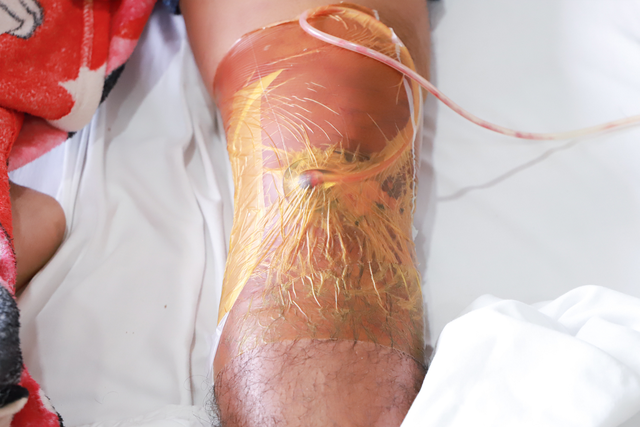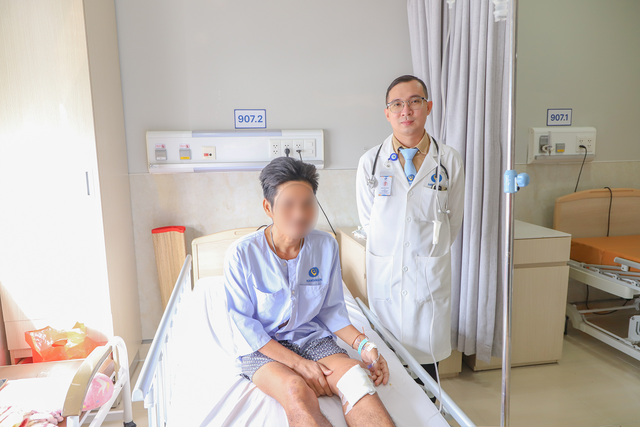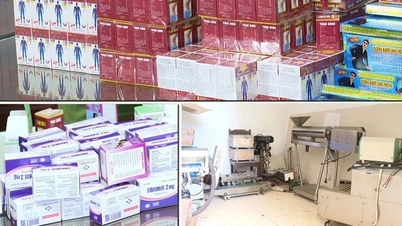Recently, Mr. HV (42 years old, Cambodian nationality) started to feel pain in his left knee and had difficulty moving. He went to a local hospital for treatment, but his condition showed no signs of improvement. He then transferred to another hospital for treatment for 5 days, but his condition even got worse. Introduced by an acquaintance, his family took him to Nam Sai Gon International General Hospital (HCMC) for treatment.
The patient was admitted to the hospital with a red, swollen left knee, severe pain, and almost immobile joint. Medical history showed that the patient had underlying diseases such as type 2 diabetes and high blood pressure. He had previously had surgery for a right groin abscess and a history of infection in the lumbar spine surgery wound.
Discovery of 'flesh-eating bacteria' causing Whitmore disease that attacks multiple organs
Initially, doctors suspected that the patient had an abscess in the left knee due to arthritis. However, when performing more specialized clinical tests such as MSCT and blood tests, doctors were surprised to discover that the inflammation in the left knee was not only abnormally large but also spread to the thigh, with signs of joint hemorrhage.
The patient's left knee joint was bleeding and the infection spread.
PHOTO. BSCC
On April 26, specialist doctor Vo Thi Huynh Nga, Head of the Department of Internal Medicine, Nam Sai Gon International General Hospital, said that the blood test results showed that he had microcytic hypochromic anemia - a condition of severe anemia and thrombocytopenia due to many causes, including infection. In addition, the imaging results also detected abscesses in many places in the lungs. Therefore, the doctors quickly conducted a culture test to identify bacteria using an antibiotic susceptibility test on the patient's body fluid sample, resulting in the identification of the bacteria Burkholderia pseudomallei.
"This is a case of severe sepsis caused by Burkholderia pseudomallei (flesh-eating bacteria) that damages multiple organs from soft tissue, knee joints and spreads to the lungs causing lung abscess. The patient is at high risk of death if not treated promptly," said Dr. Nga.
A whole month of fighting to bring life back to the patient
With the widespread infection, multi-organ damage and complex underlying disease of Mr. V., the doctors worked very closely to develop a treatment regimen of specific antibiotics, abscess debridement, and continuous knee joint aspiration for the patient using a negative pressure aspiration machine (VAC) - a specialized and modern device to treat ulcers, necrosis, deep burns, chronic wounds that are difficult to heal...
After more than 1 month of treatment, the patient had positive changes. The inflammation in the left knee was gradually controlled, the pleural effusion was reduced, and Mr. V's health stabilized. From being bedridden, the patient was able to stand up and move gently, his motor function gradually recovered and he was discharged from the hospital afterwards.
Patient recovers after treatment
PHOTO: TH
Previously, the patient had been treated for a right inguinal abscess and a lumbar spine surgical site infection. However, when the above inflammatory conditions had subsided, the patient discontinued the antibiotic regimen that was being followed. Combined with diabetes that weakened the immune system, along with favorable factors such as an unsanitary living environment and an infection in the left knee that was not properly cared for, the bacteria that caused Whitmore's disease had the opportunity to attack.
According to Dr. Nga, although the critical stage has passed, with a complicated medical history, Whitmore's disease has a high chance of recurrence if not treated properly. Therefore, to completely cure the disease, patients need to continue to adhere to outpatient antibiotic treatment and have regular check-ups every month for at least the next 3 months or even 6 months.
"Whitmore's disease, also known as flesh-eating bacteria, is a rare but extremely dangerous disease because this bacteria is resistant to many common antibiotics, requiring a long-term treatment regimen (usually 3-6 months) with specific drugs. In particular, Whitmore's disease has a high risk of causing death in cases with underlying diseases that weaken the immune system, such as the case of patient V," Dr. Nga shared.
Source: https://thanhnien.vn/dau-nhuc-goi-nhap-vien-phat-hien-bi-vi-khuon-an-thit-nguoi-tan-cong-185250426152838887.htm





![[Photo] General Secretary To Lam visits exhibition of achievements in private economic development](https://vphoto.vietnam.vn/thumb/1200x675/vietnam/resource/IMAGE/2025/5/18/1809dc545f214a86911fe2d2d0fde2e8)
![[Photo] Ready for the top competitions of Vietnamese table tennis](https://vphoto.vietnam.vn/thumb/1200x675/vietnam/resource/IMAGE/2025/5/18/9c547c497c5a4ade8f98c8e7d44f5a41)
























![[Photo] National conference to disseminate and implement Resolution No. 66-NQ/TW and Resolution No. 68-NQ/TW of the Politburo](https://vphoto.vietnam.vn/thumb/1200x675/vietnam/resource/IMAGE/2025/5/18/adf666b9303a4213998b395b05234b6a)


























































Comment (0)